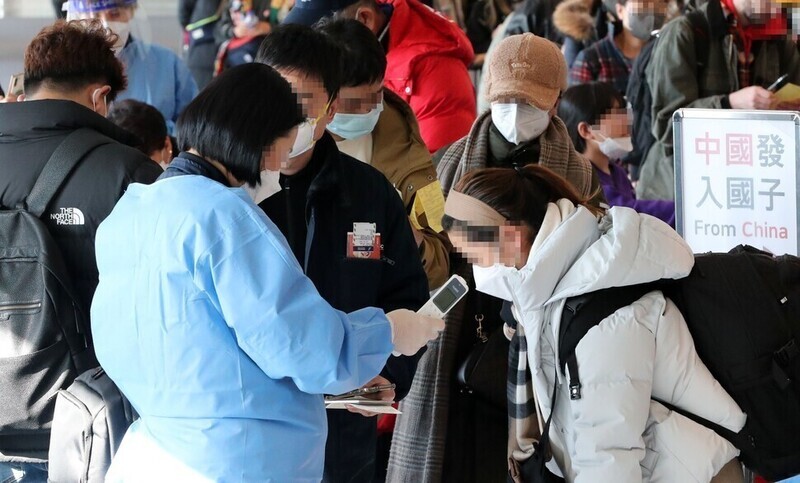hankyoreh
Links to other country sites 다른 나라 사이트 링크
[Guest essay] Economics of entry restrictions on Chinese travelers


Once again, we’re back to talking about China.
With the country suddenly ending its so-called “zero-COVID” policy at the end of last year, the massive country of 1.4 billion people was left defenseless against COVID-19.
As if a repeat of February 2020, the United States, Japan, Italy and others scrambled to bolster inspections of people entering from China.
Korea adopted the toughest entry restrictions.
Starting in early January, everyone entering Korea from China must receive tests before and after arrival; short-term visitors who test positive must be quarantined at a facility, and the issuing of short-term visas has been restricted.
China soon responded with retaliatory measures.
The Chinese Ministry of Foreign Affairs completely suspended the issuing of short-term visas to Korean nationals, saying this was a corresponding measure to Korea’s “discriminatory entry restrictions aimed at China.”
China’s reaction is just one of the costs the entry restrictions are incurring.
While expanding inspections of arrivals from China, Korea had to reconstruct inspection and quarantine facilities it had already removed and redeploy personnel.
The restrictions on short-term visas basically threw cold water on the tourism and hotel industries, which were only beginning to recover, and they made it harder for businesses that depended on migrant workers to resolve their labor shortages.
In fact, the number of foreigners residing in Korea fell from 2.52 million at the end of 2019 to 1.96 million at the end of 2021.
The supply of foreign workers is woefully insufficient, with the number of E-9 (non-professional employment) and H-2 (work and visit) visa holders falling from 260,000 and 200,000, respectively, in 2019 to 210,000 and 100,000 in May of 2022.
Regardless, if the benefits you gain from blocking people coming from China were sufficiently great, the entry restrictions would be justified.
Chinese vaccines are not very effective against the Omicron variant, and few Chinese people have experienced infection due to policies that stopped large-scale outbreaks.
As the Chinese government relaxes its quarantine policies one-by-one, infections in the country have exploded, and the need for intensified inspections to stop the spread of the virus from China has grown.
If a dangerous strain emerges in China — that is to say, a new, more severe strain that evades existing immunity — we really would have to start again from February 2020.
If a worst-case scenario were to emerge, the benefits of entry restrictions would outweigh all the aforementioned costs.
In fact, let’s look at the effect of the entry restrictions.
Some 580 of the 3,855 Chinese short-term visitors who entered Korea between Jan. 2 and Jan. 15 tested positive for COVID-19.
That is a cumulative infection rate of about 15%; many of the positive cases were asymptomatic.
When you include long-term visitors and arrivals who are Korean nationals, it’s about 11% — if we figure that there were about 20,000 total arrivals from China over the two weeks, around 2,200 were positive for COVID-19.
However, there were about 700,000 local confirmed cases during that period.
The 2,000 or so positive cases that entered from China amounted to just 0.3% of the local case total.
Even if we missed a few cases because we didn’t test everyone entering the country from China, they would unlikely prove a major burden when community-onset infections are prevalent.
The same would apply even if arrivals increased in the absence of visa issuance restrictions.
There were about 170,000 short-term arrivals from China in the first two weeks of January 2020, just before the COVID-19 pandemic.
Applying an infection rate of 11%, you could predict about 19,000 positive cases.
This is not a small total, but it would still amount to just 2.7% of local cases — not a level that would justify all the costs of the entry restrictions.
For now, a dangerous strain is unlikely to emerge, too.
According to the Korea Disease Control and Prevention Agency, most of the specimens that have entered from China are the same as the BA.5 sub-variant of Omicron that is currently prevalent in Korea.
No other country has reported the entry of a dangerous strain from China, either.
It’s good to prepare as a precaution, but at the current threat level, you can sufficiently keep an eye out for variants by bolstering pre-entry testing and testing arrivals who present symptoms.
Playing the “restrict short-term visas” card wasn’t worth the costs, even if you take into consideration the uncertainty.
We also must remember this isn’t the end of things.
China has 1.4 billion people, but 6.6 billion people live outside of China.
And the COVID-19 virus is circulating among them without restriction.
Immunity acquired through infections or vaccines will regularly and repeatedly increase and decrease, and a dangerous strain could emerge in any country.
We can’t get frightened and lock the border every time.
We mustn’t be careless, but wasn’t the lesson of the COVID-19 era that we can’t do anything and everything just to stop COVID-19?
We need a more sophisticated cost-benefit analysis and policy execution based on that analysis.
Please direct questions or comments to [english@hani.co.kr]

Editorial・opinion
![[Column] Season 2 of special prosecutor probe may be coming to Korea soon [Column] Season 2 of special prosecutor probe may be coming to Korea soon](https://flexible.img.hani.co.kr/flexible/normal/500/300/imgdb/original/2024/0426/3317141030699447.jpg) [Column] Season 2 of special prosecutor probe may be coming to Korea soon
[Column] Season 2 of special prosecutor probe may be coming to Korea soon![[Column] Park Geun-hye déjà vu in Yoon Suk-yeol [Column] Park Geun-hye déjà vu in Yoon Suk-yeol](https://flexible.img.hani.co.kr/flexible/normal/500/300/imgdb/original/2024/0424/651713945113788.jpg) [Column] Park Geun-hye déjà vu in Yoon Suk-yeol
[Column] Park Geun-hye déjà vu in Yoon Suk-yeol- [Editorial] New weight of N. Korea’s nuclear threats makes dialogue all the more urgent
- [Guest essay] The real reason Korea’s new right wants to dub Rhee a founding father
- [Column] ‘Choson’: Is it time we start referring to N. Korea in its own terms?
- [Editorial] Japan’s rewriting of history with Korea has gone too far
- [Column] The president’s questionable capacity for dialogue
- [Column] Are chaebol firms just pizza pies for families to divvy up as they please?
- [Column] Has Korea, too, crossed the Rubicon on China?
- [Correspondent’s column] In Japan’s alliance with US, echoes of its past alliances with UK
Most viewed articles
- 1AI is catching up with humans at a ‘shocking’ rate
- 2‘We must say no’: Seoul defense chief on Korean, USFK involvement in hypothetical Taiwan crisis
- 3[Column] Season 2 of special prosecutor probe may be coming to Korea soon
- 4Korea sees more deaths than births for 52nd consecutive month in February
- 5Is N. Korea threatening to test nukes in response to possible new US-led sanctions body?
- 6Is Japan about to snatch control of Line messenger from Korea’s Naver?
- 7[Guest essay] The real reason Korea’s new right wants to dub Rhee a founding father
- 8[Editorial] Korea’s surprise Q1 growth requires objective assessment, not blind fanfare
- 9Division commander ordered troops to enter raging flood waters before Marine died, survivor says
- 10Park administration’s distorted history textbooks made public